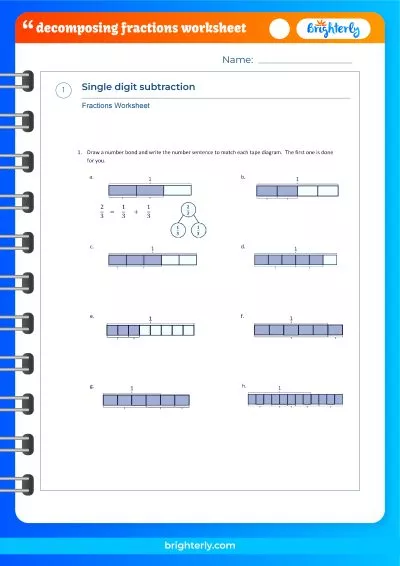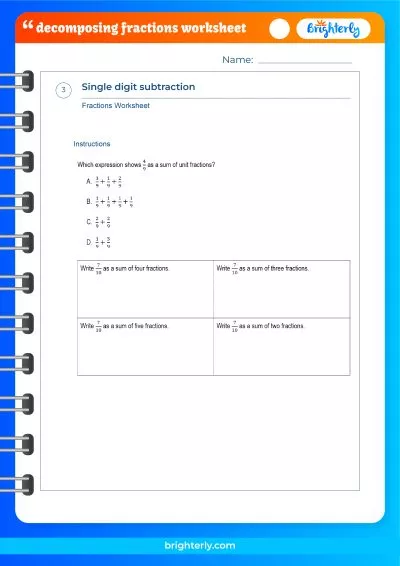Decomposing Numbers in Math – Definition, Methods & Examples
Updated on January 7, 2024
Welcome to the wonderful world of mathematics, brought to you by Brighterly, where learning is engaging, fun, and easy to understand. Today, we’ll explore a fundamental concept in mathematics known as number decomposition. Just as a builder deconstructs a building to understand the elements that make it up, in mathematics, we decompose numbers to understand their components and their interactions.
This process of decomposition is much more than a simple mathematical exercise. It forms the cornerstone for understanding more complex mathematical operations and concepts. Decomposition empowers young learners, giving them the tools to see numbers not as fixed entities, but as flexible and dynamic. It fosters a deep understanding of the number system and helps to build mental math skills. We will dive into the definition of number decomposition, examine different methods, and provide illustrative examples. Let’s dive right in!
What is Number Decomposition in Math?
Number decomposition is a foundational concept in mathematics that is often introduced in early education. When we decompose a number, we are breaking it down into smaller, more manageable parts. This might sound simple, but it forms the backbone of many more complex mathematical concepts like multiplication, division, and fraction comprehension. Decomposing numbers helps children develop a more in-depth understanding of how numbers function and interact with each other. It is a key part of building number sense and improving mental math skills.
Definition of Number Decomposition
In the most fundamental terms, number decomposition is the process of breaking down numbers into their smaller component parts. It involves splitting a number into a sum of other numbers, its multiples, or its factors. Decomposition can also involve separating a number into its individual place values. For example, the number 123 could be decomposed into 100, 20, and 3. It’s like deconstructing a building into its core components: bricks, steel, and glass.
Methods of Decomposing Numbers
Decomposing numbers can be done using various methods, each with its unique application and utility. Some of the popular methods include prime factorization, using place value, and breaking into addends. Each method serves a different purpose and can be used depending on what the problem requires. For instance, prime factorization might be used in solving problems related to fractions or ratios, while place value decomposition might be used in addition or subtraction.
Prime Factorization as a Method of Decomposition
Prime factorization is a method of decomposition where a number is broken down into its prime factors. A prime number is a number that has only two factors: one and itself. Prime factorization involves breaking down a number until all the factors are prime numbers. For example, the prime factorization of 12 is 2x2x3. This method is particularly useful when dealing with fractions or when finding the greatest common factor or least common multiple of numbers.
At Brighterly, we believe that practice is the key to mastery. That’s why we invite you to explore our decomposing numbers worksheets, where you can find an array of additional practice questions, complete with answers.
Using Place Value to Decompose Numbers
In the place value method of decomposition, a number is broken down according to the value of each digit. Each digit in a number has a certain value depending on its position or place. For instance, in the number 345, the digit 3 is in the hundreds place, 4 in the tens place, and 5 in the ones place. Hence, the number 345 can be decomposed as 300+40+5. This method is commonly used in arithmetic operations like addition and subtraction.
Breaking into Addends as a Method of Decomposition
Decomposing a number by breaking into addends means splitting the number into two or more smaller numbers that add up to the original number. For instance, the number 5 can be broken into addends in several ways: 5=4+1, 5=3+2, 5=2+2+1, and so on. This method of decomposition is often used to simplify complex addition problems and to enhance understanding of number relationships.
Properties of Decomposed Numbers
Decomposed numbers, no matter the method of decomposition, possess certain key properties. These include the property of identity (the original number does not change), the property of order (the order in which numbers are decomposed does not affect the original number), and the property of associativity (the way in which numbers are grouped when decomposed does not change the original number).
Properties of Decomposition using Prime Factorization
When decomposing numbers using prime factorization, the prime factors obtained are unique to that number, a property known as the Fundamental Theorem of Arithmetic. Also, prime factorization obeys the associative property, meaning that the way the factors are grouped does not affect the product.
Properties of Decomposition using Place Value
In decomposition using place value, the value of each digit in its place is additive, which forms the original number when combined. This implies that the number is the sum of its place values. Decomposition using place value also respects the property of order: changing the order of the place values does not affect the original number.
Properties of Decomposition using Breaking into Addends
When a number is decomposed into addends, the sum of the addends is equal to the original number, a property known as the partition property. Additionally, this method of decomposition obeys the commutative property, meaning that changing the order of the addends does not affect the sum.
Difference Between the Various Methods of Decomposition
Each method of decomposition serves a different purpose. Prime factorization is useful for understanding the multiplicative structure of a number, place value decomposition aids in arithmetic operations, and breaking into addends enhances understanding of the additive structure of numbers. The choice of method depends on the nature of the mathematical problem at hand.
Equations Illustrating Number Decomposition
To illustrate the different methods of decomposition, let’s consider the number 24. In prime factorization, 24 can be decomposed as 2x2x2x3. Using place value decomposition, 24 becomes 20+4. When breaking into addends, 24 can be represented as 10+10+4. Each method gives us a different way to view and understand the number 24.
Writing Equations Using Prime Factorization
When using prime factorization to write equations, we list all the prime factors of the number. For example, for the number 36, the prime factorization is 2x2x3x3. Hence, we can write the equation as 36 = 2x2x3x3.
Writing Equations Using Place Value Decomposition
In place value decomposition, we split the number into the value of each digit in its place. So, for the number 562, we have 500+60+2. The equation becomes 562 = 500 + 60 + 2.
Writing Equations Using Breaking into Addends
When breaking a number into addends, we split the number into two or more smaller numbers that add up to the original number. For instance, for the number 15, we can write the equation as 15 = 10 + 5.
Practice Problems on Decomposing Numbers
To help students understand the concept of decomposing numbers, teachers can provide a range of practice problems. For example, ask students to decompose the number 48 using prime factorization, place value, and breaking into addends. This practical application of knowledge strengthens understanding and allows students to see the value of each method of decomposition.
Conclusion
Number decomposition is more than just a mathematical technique; it’s a journey of discovery into the world of numbers. It’s a fascinating exploration that unveils the dynamic and flexible nature of the number system. With Brighterly, we simplify this journey, making it engaging and fun for young learners.
By understanding how to decompose numbers and the properties of decomposed numbers, children develop stronger number sense, enhancing their mental arithmetic skills. Moreover, they acquire the ability to approach mathematical problems with confidence and flexibility.
At Brighterly, our mission is to illuminate the path of learning, making it brighter and clearer for every child. Stay tuned for more exciting explorations into the world of mathematics!
Remember, every number holds a story waiting to be decomposed!
Frequently Asked Questions on Decomposing Numbers in Math
What does it mean to decompose a number?
Decomposing a number means breaking it down into its smaller parts. These parts could be other numbers that add up to the original, its multiples, or its factors. It’s a method used to simplify and better understand the nature and properties of numbers.
What are the different methods of decomposing numbers?
There are various methods for decomposing numbers, including prime factorization, place value decomposition, and breaking into addends. Each of these methods provides a unique perspective on the number and is useful in different mathematical situations.
How does decomposing numbers help in mathematical problem-solving?
Decomposing numbers is a powerful strategy for problem-solving. It allows students to simplify complex problems, making them more manageable. It provides flexibility in the way we approach problems. For instance, decomposing numbers can simplify addition and subtraction problems, or aid in understanding the multiplicative structure of numbers.






